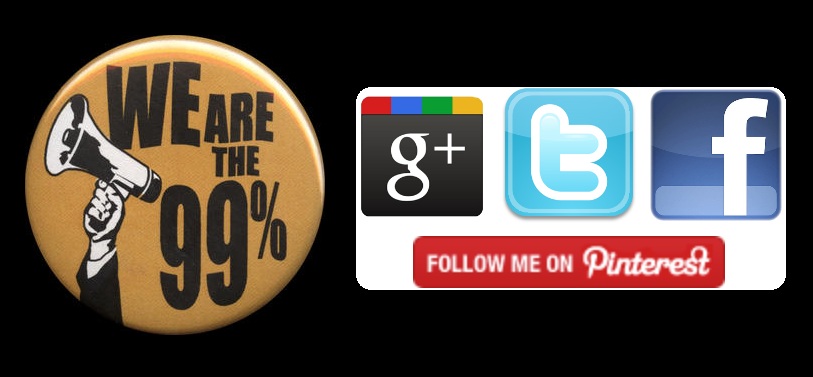14 Experts Predict 2013 Social Media Marketing Trends for Car Dealers and Local Business Owners
 First of all, I want to thank Mr. Bryan Armstrong for posting a link and article snippet on the Google+ Community titled "Automotive Social Media Marketing" which led me to an article... which referenced and led me one step further to the AT&T Networking Exchange Blog that I am re-posting for the benefit of ADM Professional Community members below.
First of all, I want to thank Mr. Bryan Armstrong for posting a link and article snippet on the Google+ Community titled "Automotive Social Media Marketing" which led me to an article... which referenced and led me one step further to the AT&T Networking Exchange Blog that I am re-posting for the benefit of ADM Professional Community members below.
My goal is to get our community of automotive marketing practitioners to think about where the car business is heading with our use of social media marketing strategies and tactics, in the hope of stimulating some valuable discussion and commentary.
For example, take a look at Jeff Bulas' (#3) prediction (more of a projection?) where he describes what sounds like car dealers connecting the dots between search engine marketing strategies and how they will begin to understand the correlation between sound content creation and publishing programs as part of their overall marketing strategy. There are few areas within the very large world of automotive digital marketing that has more effectively captured the attention of car dealers than taking action to ensure having their websites and published information show up in the Google Search Engine results which appear for their customers making automotive related inquiries... To Jeff's point, as more and more dealers grasp the connection between publishing "User Generated Content" as part of a daily Content Marketing and Earned Media strategy, their perspective on Social Media Marketing and how it delivers a Return On Investment (ROI) will evolve and become a lot more sophisticated.
All 14 of these predictions are well worth carefully reviewing and considering in your dealership's 2013 marketing strategy, but take a close look at Margie Clayman's (#4) predictions. Her words make a lot of sense and sound very likely to occur, at least to my admittedly biased ears... Here's a quote from Margie predictions:
"I predict that in 2013 small businesses will start seeing social media more as a tool and less as an entity unto itself. Instead of asking what social media is, they will ask how they should be using it and why."
What Margie says under the guise of a prediction makes a lot of sense, and is just plain good guidance, whether or not labeled with the "Predictions for 2013" moniker or not. As you read through these 14 so-called predictions, you will find that most of them should be considered good advice, and brimming with opportunity for competitive advantage.
All of the renowned and highly respected writers, speakers and practitioners whose "predictions" are listed in the article below are knowledgeable and obviously put serious thought into their answers to Cheryl Burgess's questions. I found that reading the predictions caused me to think and consider many of my own strategies and tactics, so as to be positioned for a competitive advantage in 2013... When it really comes down to why any of us would bother with social media and the marketing, engagement and communications capabilities it offers to car dealers; if there were no opportunity for competitive advantage, then why would we bother with it?
After you check these predictions out, please post a comment about which ones you found credible and ringing of truth, and which ones you considered to be more fantasy than fact... Finally, the question that Cheryl closed her article with, which I have boldened and highlighted in red font. I will echo to our professional network... What are YOUR predictions regarding social media and the way car dealers will use it in 2013?
Not The Same Old, Same Old Social Media
 When Cheryl started this post, she wanted to share 13 Social Media Predictions for Small Business (including car dealerships) in 2013. However, for those of her readers who might be superstitious, Cheryl didn't want to jinx the New Year before it even began. So, she decided to go with 14 predictions instead. Cheryl suggests that there is no need to worry about doomsday prophecies from the Mayans or Nostradamus. As shown by their predictions for 2013, the experts Ms. Burgess consulted see only a bright future ahead for small businesses, car dealers and their ability to receive business benefits from social media marketing practices. ADM Professional Community members are encouraged to visit Cheryl's article on the AT&T Networking Blog for Small Business at NetworkingExchangeBlog.ATT.com/Small-Business.
When Cheryl started this post, she wanted to share 13 Social Media Predictions for Small Business (including car dealerships) in 2013. However, for those of her readers who might be superstitious, Cheryl didn't want to jinx the New Year before it even began. So, she decided to go with 14 predictions instead. Cheryl suggests that there is no need to worry about doomsday prophecies from the Mayans or Nostradamus. As shown by their predictions for 2013, the experts Ms. Burgess consulted see only a bright future ahead for small businesses, car dealers and their ability to receive business benefits from social media marketing practices. ADM Professional Community members are encouraged to visit Cheryl's article on the AT&T Networking Blog for Small Business at NetworkingExchangeBlog.ATT.com/Small-Business.
1. Meghan M. Biro @MeghanMBiro – Founder and CEO of TalentCulture Consulting Group and the TalentCulture World of Work Community. “In 2013, for businesses small & large, I predict that the quality of online relationships and content will rise to the occasion in the vast sea of social media. Also, crowdsourcing will become a more active player in the mainstream social enterprise.”
2. David Brier @DavidBrier – Chief Gravity Defyer at DBD International, Ltd. – “In 2013, small businesses will need to strengthen their ties to their customers as the world keeps getting smaller. So much more is available than ever before. Thus, the competitive edge will be built on those relationships and bonds. In addition, small businesses can become the official ambassadors of excellent customer service in a world that’s going increasingly automated. As more and more “touch points” become “streamlined” at the expense of personal human contact, the companies with excellent personnel and live customer service representatives will outshine and outperform their competition.”
3. Jeff Bullas @jeffbullas – Account Director- Infinity Technologies, Social Media Marketing Blogger, Speaker and Strategist – Author -”Blogging the Smart Way – How to create and Market a Killer Blog with Social Media” “Google has realized that people voting for content they like with Retweets, Facebook likes, plus +1′s and comments is important and increasingly relevant in what they serve up in Google search results. Google+ was launched just over 12 months ago to capture those social signals, and today the Google +1 button is used over five billion times every day. In 2013 you will see small companies starting to realize that social media is also important for Search Engine Optimization (SEO). Companies will begin to understand that social, content, and SEO are linked and more integrated than ever.”
4. Margie Clayman @MargieClayman- Vice President of Client Services, Clayman Marketing Communications, Inc. “I predict that in 2013 small businesses will start seeing social media more as a tool and less as an entity unto itself. Instead of asking what social media is, they will ask how they should be using it and why. In the end, this will increase the effectiveness of their social media marketing efforts.”
5. Jon Ferrara @Jon_Ferrara – CEO Nimble, Inc. “Nearly every small business is experimenting with or planning on using social media because they understand they need to go where their audience is. Listening and engaging and being discoverable online is critically important today in growing their businesses. 2013 will be the year Social Media moves out of Community Management and Marketing to Social Selling and Customer Engagement.”
6. Sam Fiorella @samfiorella – Partner at Sensei Marketing and Author of Influence Marketing “Small Businesses in 2013 will tire of broadcast social media campaigns and messaging and invest in monitoring tools like Jungoo.com, Shoutlet.com or others to better segment their audience, effectively target influencers and accurately measure the impact of those efforts. Next, employees—the businesses’ biggest brand ambassadors—will become trained and empowered to become actual influencers across social channels.”
7. Mike Johansson @mikefixs – Lecturer in Communication at the Rochester Institute of Technology (RIT) and Social Media Strategist for Fixitology LLC – “2013 is the year that small businesses finally acknowledge that social media needs to be part of the daily workload. Depending on whose numbers you believe, somewhere between 20 and 25 percent of small businesses use social media for customer engagement, customer service, community building and selling. In 2013 small businesses will realize they either get on that bus or they’ll be waving goodbye to the opportunity to be in front of people … and some, if not all, of their business.”
8. Wendy Marx @Wendy Marx – President – Marx Communications-“In 2013, for B2B small businesses it will be more use of content marketing, especially content curation, as a way of engaging customers. Small businesses will make greater use of LinkedIn as the platform continues to expand its offerings. Finally, the coming year will see a greater integration of social media into all marketing practices so it becomes a part of a small business’ way of doing business.”
9. Steve Olenski @steveolenski – Sr. Content Strategist at Responsys – “In 2013 I think (and maybe it’s wishful thinking) that more and more small businesses will begin to dive into the visual side of social media, (i.e. Pinterest and Instagram). I have said this a million times, but you have to look at your computer/mobile screen the way you do a TV. People do not read TV, they watch it. Consumers want to see something—not just read it.”
10. Tom Pick @TomPick – Digital Marketing & PR Consultant – Webbiquity- “In 2013, small businesses, and larger ones too, will get more sophisticated about their measurement of social media results. They will view social media marketing tactics within the larger framework of their overall Web presence—how it supports what they are doing in PR, website optimization, search advertising and other areas of marketing. Their measurement will be less about direct, linear ROI and more about how social sharing and engagement fits into and enhances their overall web marketing and lead generation strategies.”
11. Alex Romanovich @AlexRomanovich – Managing Partner - Social2B, Inc, Adviser – The CMO Club – “SMBs will continue to test social media, while more aggressively increasing their budgets allocated to social media in any form. By now, the SMB community is seeing some positive results via social media and will continue to test the channel, conversions, ecommerce or social commerce, etc. For the first time, SMBs will start paying even closer attention to metrics and analytics—they will want to know more about their conversion rates and ROI, although they will continue to be challenged by the complexity and growing pains of the social environment. SMBs will also use more social networks—besides LinkedIn, Twitter and Facebook, SMBs will continue to discover Google+, Slideshare, etc.”
12. Gary Schirr @ProfessorGary – Assistant Professor – Marketing, Radford University - “In 2013 savvy small businesses around the globe will learn valuable photo and video-editing skills to help drive their social media marketing efforts. Using their own cameras, smartphones and tablets, small businesses will leverage newly found creative skills to create content that impacts their audience. They will also solicit visual content from employees and customers. Small businesses will develop an eye for visual content marketing opportunities while learning editing tools such as iMovie, MovieMaker, Photoshop and PaintShop to help energize their business marketing approach.”
13. Deborah Weinstein @debweinstein – President & Partner, Strategic Objectives “2012 saw a major surge in mobile adoption rates, and 2013 will be all about the apps that lead to social sharing. Mobile is an effective brand building tool for small business given its powerful ability to geo-target consumers and promote local sales. In 2013, we will see a focus on quick, easy and highly visual apps, including Instagram, Viddly, Cinemagram and Keek. These apps are the ‘140 characters’ of visual, social sharing. Small business can use these free, easy-to-use tools to get the message out to their audience on such a short, quick-consumption platform.”
14. Patricia Wilson @brandcottage – President/Founder BrandCottage - “The biggest shift we will see is in content creation. It is relatively easy and inexpensive to create beautiful photos and videos for social media. Small business are beginning to reach their comfort level with social media and will employ more tactics with Instagram, Pinterest, Tumblr and other social nets.”
What trends in social media do you see taking shape in the coming year?
Check out the original source of this post:
networkingexchangeblog.att.com/14-experts-predict-2013-social-media...
The following Automotive Social Media Infographic gives us some historical perspective on where the car business was with our use of social media back when we were headed into 2012... A lot has changed, so what will 2013 have in store for the ways in which automotive marketers seek to gain a competitive advantage via innovation and more effective use of social media channels?




 Here's the short version of what you should be doing with your page: log in as the page (top right arrow next, "Use Facebook as:") and go like other pages and posts. Done right, it should take no more than 5-10 minutes a day. Like your local newspaper. Like local charities. Like other local businesses. Like the posts that are on those pages that you truly enjoy (more on that later). It takes a certain creative and professional personality to comment appropriately as a dealership on other Facebook pages. It takes the ability to read and click buttons to like things that others post.
Here's the short version of what you should be doing with your page: log in as the page (top right arrow next, "Use Facebook as:") and go like other pages and posts. Done right, it should take no more than 5-10 minutes a day. Like your local newspaper. Like local charities. Like other local businesses. Like the posts that are on those pages that you truly enjoy (more on that later). It takes a certain creative and professional personality to comment appropriately as a dealership on other Facebook pages. It takes the ability to read and click buttons to like things that others post.























